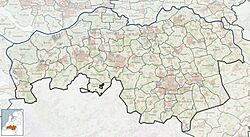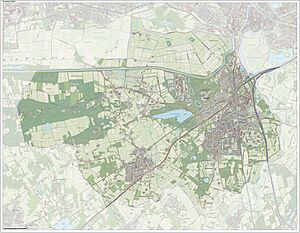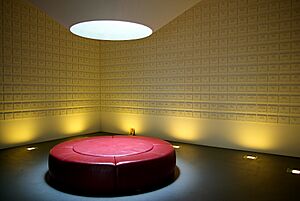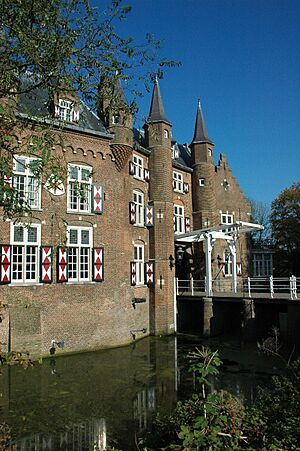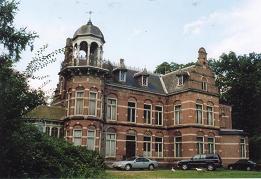Vught facts for kids
Quick facts for kids
Vught
|
|||
|---|---|---|---|
|
Town and municipality
|
|||
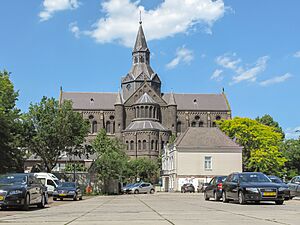
Former Saint Peter church in Vught
|
|||
|
|||
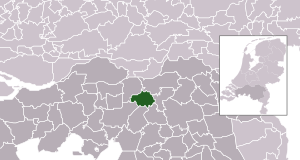
Location in North Brabant
|
|||
| Country | Netherlands | ||
| Province | North Brabant | ||
| Government | |||
| • Body | Municipal council | ||
| Area | |||
| • Total | 34.44 km2 (13.30 sq mi) | ||
| • Land | 33.48 km2 (12.93 sq mi) | ||
| • Water | 0.96 km2 (0.37 sq mi) | ||
| Elevation | 5 m (16 ft) | ||
| Population
(May 2014)
|
|||
| • Total | 25,769 | ||
| • Density | 770/km2 (2,000/sq mi) | ||
| Demonym(s) | Vughtenaar | ||
| Time zone | UTC+1 (CET) | ||
| • Summer (DST) | UTC+2 (CEST) | ||
| Postcode |
5260–5266
|
||
| Area code | 0411, 073 | ||
Vught is a town and a municipality in the southern Netherlands. It is located in the province of North Brabant, just south of the city of 's-Hertogenbosch. Many people who work in 's-Hertogenbosch live in Vught. In 2004, a Dutch magazine called Elsevier named Vught the "Best place to live."
Contents
Towns and Villages in Vught
The municipality of Vught includes these areas:
- Cromvoirt
- Helvoirt
- Vught
Vught's Location on a Map
This map shows where Vught is located. It helps you see the different parts of the municipality.
Vught's Past: A Look at History
Early Days of Vught
Vught was first mentioned in history books around the 11th century. By the 14th century, a group called the Teutonic Order had a special building there. In 1328, the people of Vught were given the right to govern themselves by the Duke of Brabant.
Vught During the Eighty Years' War
The Eighty Years War was a long conflict in the Netherlands. During this time, Vught was a place where battles happened between Catholic groups and the soldiers of William of Orange. In 1629, after a victory by Frederick Henry, Prince of Orange, the main church in Vught became a Protestant church.
Vught in World War II
During World War II, when Nazi Germany occupied the Netherlands, they built a camp in Vught. This camp was known as "Kamp Vught" or Herzogenbusch concentration camp. It was used to hold many prisoners, including Jewish people and political activists, who were captured in Belgium and the Netherlands.
The camp guards included SS men and some SS women. The SS used the camp to gather prisoners before sending them to other camps in Poland and other areas.
One sad event involved a group of 74 women who were punished severely for helping another prisoner. They were forced into a tiny cell for many hours. Sadly, some of the women died, and others were hurt physically or mentally. The camp commander responsible for this was later removed from his position.
Famous Dutch underground members, Corrie and Betsie ten Boom, were held at Kamp Vught in 1944. They were later sent to another camp. Vught was also a stop for many women who were forced to work in factories making camera parts. Poncke Princen, who later became known for joining Indonesian fighters against Dutch rule, was also imprisoned here for his actions against the Nazis.
Canadian soldiers helped free Vught at the end of the war.
Vught Camp After the War
After World War II, the camp was used to hold Germans and people who had helped the Nazis. Today, part of the camp is a national monument. It helps people remember what happened during the Nazi occupation.
Later, some buildings at the camp were turned into homes. These homes were for families from the Moluccan islands who moved to the Netherlands after Indonesia became independent. These families included former soldiers who had served in the Dutch armed forces.
PI Vught: A Modern Prison
Since 1953, a part of the former camp has been used as a prison. It was first a prison for young people called Nieuw Vosseveld. Today, it is known as PI Vught. It is a high-security prison with many separate units and can hold up to 750 prisoners.
Cool Places to See in Vught
Just outside Vught, there is a lake called IJzeren Man, which means 'Iron Man'. It got its name from the large machine that dug it between 1890 and 1915. The sand from the lake was used to help expand the nearby city of 's-Hertogenbosch. The lake is about 2 kilometers long and has a small island. Now, it's a popular spot for fun and relaxation.
Maurick Castle is a very old building, dating back to the 13th century. In 1629, Frederick Henry, Prince of Orange used it as his base during a battle for 's-Hertogenbosch. Today, the castle is home to a restaurant.
Vught also has the Bredero barracks, which is a training center for the Dutch Ministry of Defence. They train people there for special defense situations.
In 2021, the village of Helvoirt and its surroundings became part of Vught. This also meant that a part of the Loonse en Drunense Duinen national park is now in the Vught municipality.
Ewald Marggraff and Zionsburg
Ewald Marggraff was a wealthy nobleman who lived in Vught. He was a bit of a hermit, meaning he lived a quiet life away from others. He bought a lot of land and buildings. He often had disagreements with the local government because he let his properties become run down. However, this allowed the land to return to nature, and many animals that had disappeared elsewhere came to live there. On December 7, 2003, his manor, Zionsburg, burned down, and his body was found inside.
After his death, Marggraff's sisters created a group called Marggraff stichting. This group now manages his large landholdings. They allow people to visit the forests and are working to rebuild Zionsburg.
Getting Around Vught
Vught has a train station. From here, you can travel to Amsterdam and Utrecht (by way of 's-Hertogenbosch'), Maastricht (by way of Eindhoven), Tilburg, and Nijmegen. Major highways, Highway 2 / E25 and Highway 65 / N93, also cross in Vught. There are also two Arriva bus lines that connect Vught to the Jeroen Bosch Hospital, school areas, and the central station in nearby Den Bosch.
Famous People From Vught
People in Public Service
- Alexander Gogel (1765–1821): The first finance minister of the Batavian Republic.
- Betsie ten Boom (1885–1944) & Corrie ten Boom (1892–1983): Sisters who bravely hid Jewish families during WWII. They were held at Kamp Vught.
- Frans Teulings (1891–1966): A Dutch politician who was a deputy prime minister.
- Anton de Kom (1898–1945): A Surinamese resistance fighter and writer who fought against colonial rule.
- Damiaen Joan van Doorninck (1902–1987): A naval officer who was a prisoner of war in Colditz.
- Ewald Marggraff (1923–2003): A nobleman from Vught, known for his unique way of living and his land.
- Edy Korthals Altes (1924–2021): An economist, Dutch diplomat, and someone who worked for peace.
- Ad Geelhoed (1942–2007): A law professor and civil servant.
- Jeroen Oerlemans (1970–2016): A Dutch photographer and war reporter.
Artists and Performers
- Erna Spoorenberg (1925–2004): A Dutch opera singer (soprano).
- Misha Geller (1937–2007): A Russian viola player and composer.
- Joost Prinsen (born 1942): A Dutch actor, TV presenter, singer, and writer.
- Mina Witteman (born 1959): A Dutch author who writes books for children.
- Maarten van der Vleuten (born 1967): A Dutch music producer, composer, and recording artist.
- Jan-Hein Arens (born 1974): A Dutch painter, sculptor, and illustrator.
Sports Stars
- Tonny van Lierop (1910–1982): A Dutch field hockey player who won a bronze medal at the 1936 Summer Olympics.
- Harry Schulting (born 1956): A Dutch Olympian in hurdles and a record holder.
- Pierre Hermans (born 1953): A former field hockey goalkeeper who competed at the 1984 Summer Olympics.
- Simon Tahamata (born 1956): A former Dutch and Belgian football player.
- Bas de Bever (born 1968): A Dutch former professional BMX racer.
- Martijn Bok (born 1973): A retired Dutch tennis player.
- Vincent Kortbeek (born 1982): A retired Dutch Olympian in bobsleigh.
- Paul Beekmans (born 1982): A football manager and former player.
- Koen van de Laak (born 1982): A former professional football player.
- Wouter van der Steen (born 1990): A Dutch professional football goalkeeper.
- Indy de Vroome (born 1996): A Dutch tennis player.
Images for kids
See also
 In Spanish: Vught para niños
In Spanish: Vught para niños





